The computer screen flickered momentarily as a man with a headset and a beaming smile appeared, offering a warm “Hellooo!” in a delightful French accent. Drafting tables and 3D architectural models were neatly displayed in the background behind his desk.
Anyone who has ever met Arthur Mamou-Mani knows that his infectious grin will win you over in seconds, followed closely by his undeniable talent and creativity as an architect, artist, teacher, and an innovator with an eye for sustainability. Arthur has been creating art installations for Black Rock City since 2013. He was gracious enough to sit down for a recent interview to discuss his experience as the creator of “Catharsis,” a virtual reality (VR) art installation in BRCvr, one of the Recognized Universes in the 2020 Burning Man Multiverse.
Here’s what he had to say…

How did you first get connected with Burning Man?
Arthur: Actually, strangely enough, it was with my university. We started bringing students to Burning Man about seven years ago. I think — 2013 was our first year building on playa with the students, actually building the students’ structures. It was part of our curriculum: bringing the students to Burning Man, and making the structures happen.
It was amazing. The first year we brought two structures: a big, giant fractal scaffolding, and then a sort of shipwreck boat thing. The year after that, there were, I don’t know, like three of those projects. It just kept on growing. I think, at the time, Bettie June Scarborough was kind of our mentor.
Then I started submitting pieces as myself. “Tangential Dreams” was the first one, and then “Galaxia.”
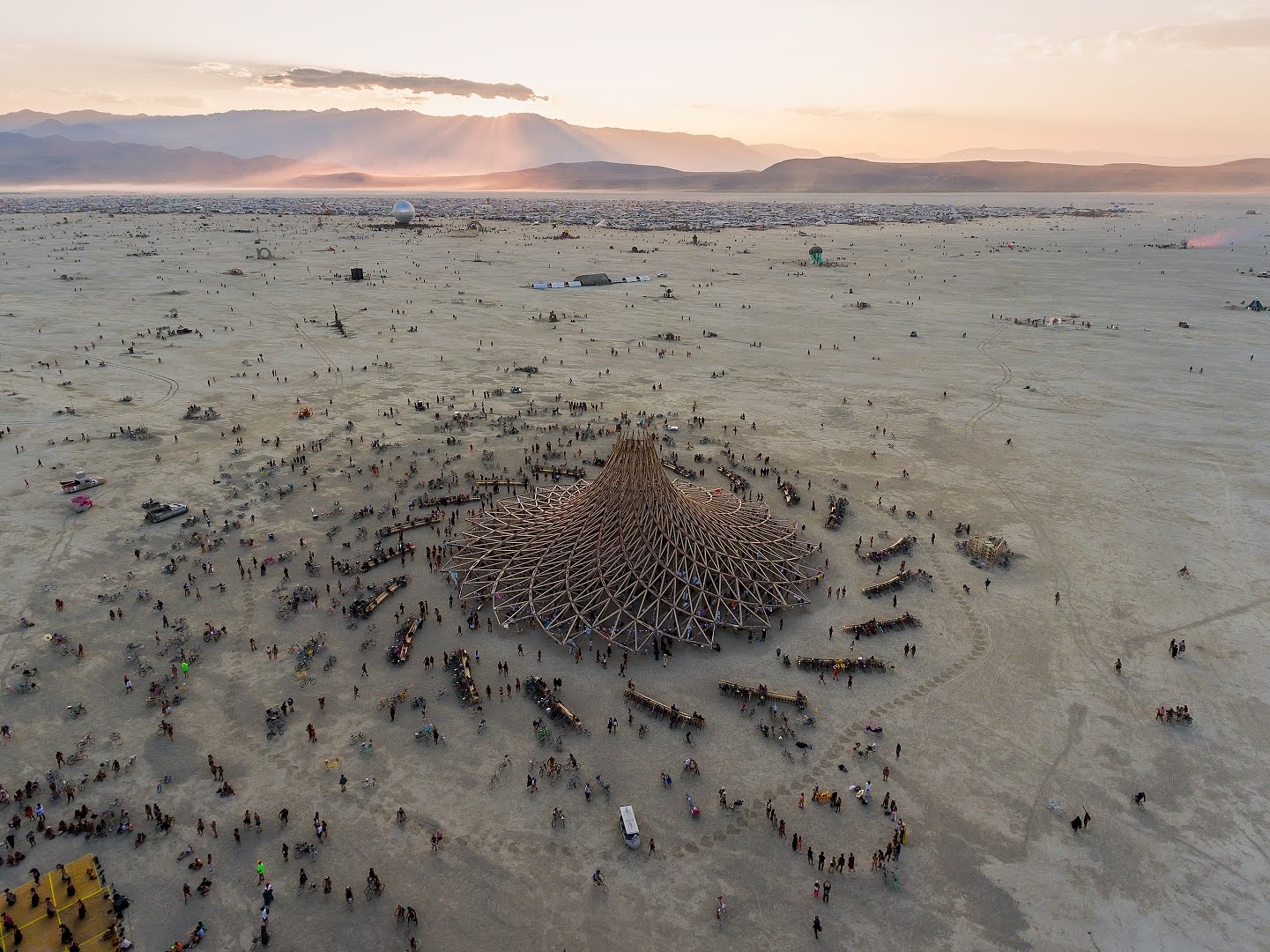
Speaking of teaching, you’ve mentioned in the past that the 10 Principles of Burning Man are part of your architecture curriculum. What’s the story behind that?

Arthur: When we started — I say ‘we’ because my colleague Toby Burgess is the one who actually introduced me to Burning Man — we wanted to teach something that had, let’s just say, an experimental nature but also communicated our values. And we are very inspired by Buckminster Fuller. So we really believe in things like self‑reliance, and the Spaceship Earth, and stuff like that. We realized that Burning Man was all about that — Leave No Trace. We were inspired by the fact that people assemble stuff on playa and disassemble it, and deal with their waste.
It’s something very interesting, because it’s sort of an experimental city that tries to be self‑sufficient. So we thought it was perfect. But we had no idea you could submit art and then get a grant. That came later.
How did your team pivot from, “Hey, we’re gonna build an awesome structure on the playa again this year,” to — all of a sudden — the pandemic puts the event on pause and, “Oh wait, we have to create an online experience in virtual reality!”
Arthur: At first, we went really far with the design for “Catharsis.” We were just about to start the fabrication in Reno, NV. We had found a person who was willing to fabricate it, we had the drawings, we had it engineered. I mean, we were so close.
Then it was all just, kinda, called off. At that point, I heard that there was this virtual reality thing called BRCvr, and the theme was the Multiverse.
I started talking to Dezeen, and I asked, “Could I make a call for action?” We obviously didn’t know how to do VR stuff, so we reached out to the community about bringing “Catharsis” to BRCvr. Back in the studio, I also have a colleague who’s really skilled at Unity, which is a game engine simulator.
All the pieces sort of started coming together as soon as we did this call-to-action article for the community and put it online. Greg Edwards, who created the virtual BRCvr on AltSpace, reached out and told us, “I’ve spent 10 years recreating Black Rock City in AltSpace.” So he was like, “This is perfect! Let’s put your structure in the Multiverse.”
That’s how it started. Then we started talking technically, how to do it — first putting it into Unity, then putting it into AltSpace, and making sure the AltSpace thing is aligned.
I found it quite poetic. It’s not just geeky. I learned that the more polygons, the more elements there are, the slower it is. So the better it looks, the worse the experience is. There is this sweet spot to be found between what is real and what is an image, what is a physical object and what is a texture. You start designing very differently in that environment with these constraints than you would in real life.
For example, our real-life model needed bolts to hold it together. But Greg was like, “You don’t need the bolts.” I also wanted our engineer to validate the structure, as usual. But it’s just virtual reality, so you obviously don’t need an engineer to validate the structure.
Going from this super hyperreal thing at Burning Man, with 70mph wind and stuff, to just trying to save memory in a computer was an interesting process. [laughs]
Everyone always asks, “How does Burning Man do it?” And this year, with BRCvr especially, we saw the resilience of the community, and how everyone takes part in it. It’s something that’s hard to explain, but it’s an amazing thing to witness — how people collectively wanted to build worlds and help each other, all on a volunteer basis. We all did it because we just wanted it to exist. All of us love this spirit of innovation that Burning Man offers. I guess we were just so excited about it. Plus we were all in confinement, so we might as well, right?
That really shows the spirit of this community. I think virtual reality and this community is how we keep the momentum, how we keep the excitement — it’s what Burning Man is made of. That’s the fuel of Burning Man. It’s the excitement of the community.
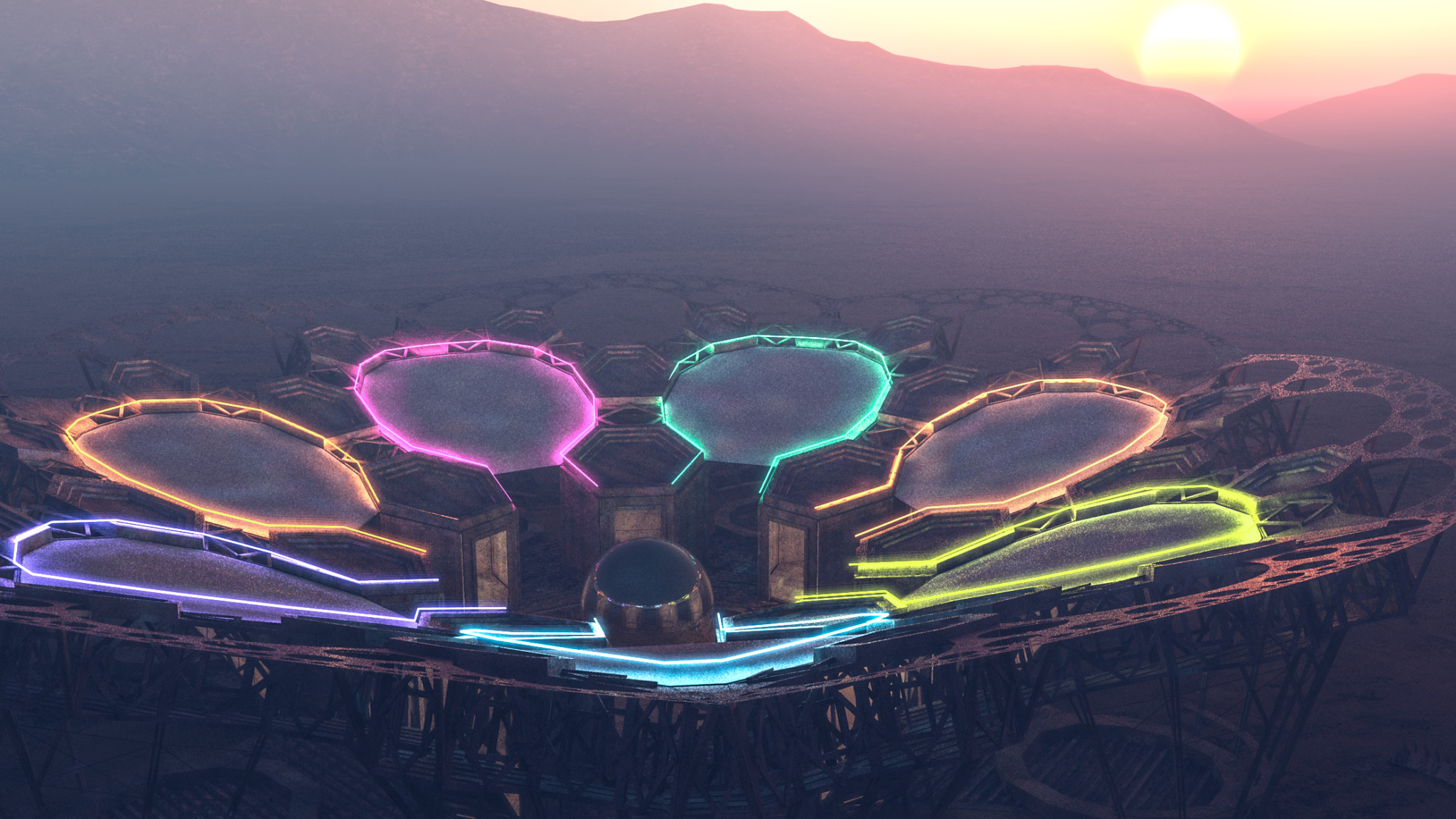
How did you come up with the concept for “Catharsis,” and who was involved?
Arthur: If you look behind me there [points to a 3D wood model of the structure sitting on a shelf behind him], it was basically after “Galaxia” happened. We had to fundraise, like everyone. We had to fundraise our project and we ended up with a bit of a debt. Luckily, I got introduced to Mikolaj Sekutowicz who leads an art foundation called Therme Art Program. We had a meeting and he was like, “I want to help you.” He canceled our debt, which is brilliant. But he also said, “Beyond that, I’d like to do a camp that speaks about the sustainable approach around the 10 Principles.” Which is not something that intuitively people understand. I mean, obviously it’s called Burning Man and people are kind of flying in from all over the world to go there. But there is a real experimental nature to it that helps us learn about sustainability.
I think people are not really fully understanding how this works, especially because we’re burning projects. That seems to be the main issue.
While we were doing “Galaxia,” actually, the Burning Man Journal interviewed me and Jerry James, the first carpenter of the Man. It’s really a beautiful story. He had disconnected with Burning Man after a disagreement, but when he saw “Galaxia,” he was like, “I want to go back to build this. That’s challenging carpentry. I want to be part of it.”
To be honest, I think he and Larry Harvey hadn’t reconnected since, I don’t know, 10 or 12 years? What’s really nice is that when we first opened the workshop to build “Galaxia,” Jerry picked up the phone and called Larry. So they met again that year, 2018, just before Larry passed.
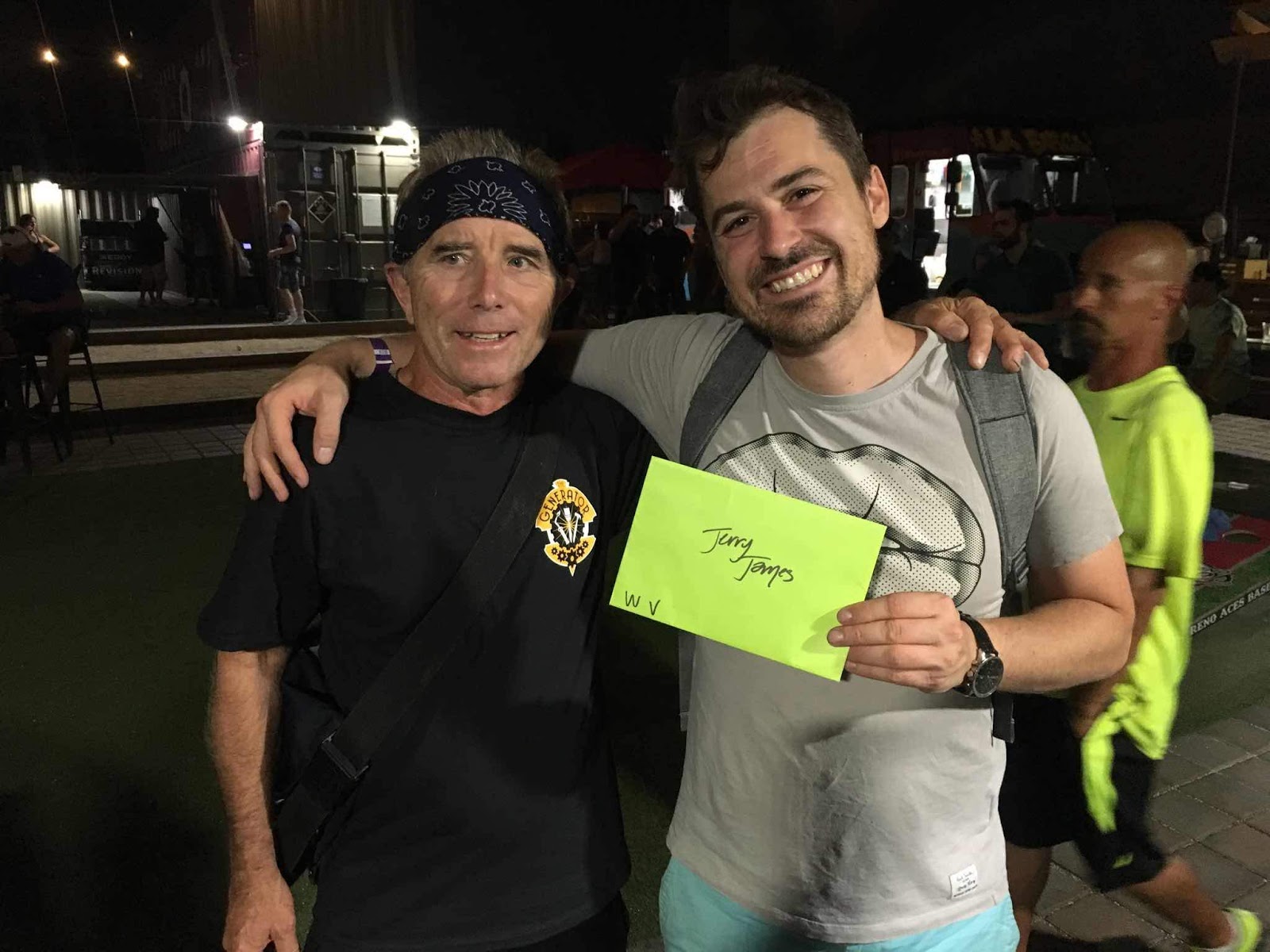
They kind of reconnected around the building of the Temple, which is one of the beautiful aspects of temple building, I think. It’s like this higher purpose.
Then while we were building, Jerry kept on telling me, “Could we NOT burn it? Can we find other things to do about it?” He kept on telling me that, and obviously, his word is important.
I just shrugged and said, “Well, I think we have to, because that’s the ritual. That’s just what happens.” I wouldn’t really question something that seems to be established. Although Burning Man creates rules, and it sort of invites us to bend them at the same time.
It sounds like you were originally designing a physical version of “Catharsis” that could be disassembled, rather than burned. Do you — as someone who is very environmentally conscious about your process and the materials you use — feel that disassembly could become a substitute for burning structures?
Arthur: The idea of disassembly is something that I feel could be ritualized, like burning.
“Galaxia,” for example, had a radial symmetry — like petals of a flower — which created a flowing movement during the build. So in the assembly and the disassembly of structures, there could be rituals or choreographies that are as exciting as the act of burning.
I think that’s important, because there’s a real cathartic thing about burning that one needs to also find in the process of taking something down to rebuild somewhere else.
I really do think we could ritualize that, and I think that’s what I love. At Burning Man, when you have the Lamplighters coming through, when you have all these rituals that are making it a place of symbolism beyond just a city, I think it could be nice to find a new symbolic path through disassembly.
And yes. After disassembly, “Catharsis” was intended to then be re-assembled in other cities, other places, so that other people can see what one could otherwise only see on playa. I think that really helps to push Radical Inclusion, as well.
We originally wanted to bring “Catharsis” back to London. It just so happens that the Somerset House agreed to have it in their courtyard, which is amazing because it’s in the center of London, right next to Piccadilly Circus. So there would have been this empty theater near Piccadilly Circus full of playa dust.
I got really excited, because then people could write notes and things towards the future location. So even though you are in Black Rock City, you could write messages and know that these words will be in London. Immediately you think differently than if those words were going to be burned.
While this year’s event is still up in the air, do you hope to build “Catharsis” in Black Rock City in the future? How do you think it’ll feel, having experienced “Catharsis” first in VR and then getting to experience it on the playa?
Arthur: I really hope it happens. This piece was hard, logistically. I remember when we submitted “Catharsis,” I had Katie Hazard, the head of the Art Department for Burning Man Project, on the phone. And she was like, “Arthur, you know, we want to help on this project, but we’re not quite sure how because it’s in the city so it’s a camp, but it’s also an art piece, and it’s also an amphitheater which is like a municipal function — like what the Temple does or what the Man does. So we’re just not quite sure which category to put it in.”
For a while, we were discussing how to even make it happen. Strangely enough, I wanted it to be sort of polar opposite to the Temple, in the central 6:00 Plaza, behind Center Camp. I thought it was a nice yin to the Temple’s yang.
In real life, you can’t just show up and say, “I want to be at 6:00.” But in virtual reality, that’s a very different thing. So “Catharsis” ended up in the 6:00 Plaza in BRCvr. And it’s still there for you to visit.
It’s funny because if we end up building it, I think “Catharsis” will probably be the first project that was in virtual reality first, then made in real life on the playa after. I think people will relate to it in a very different way because they have seen it in virtual reality first.
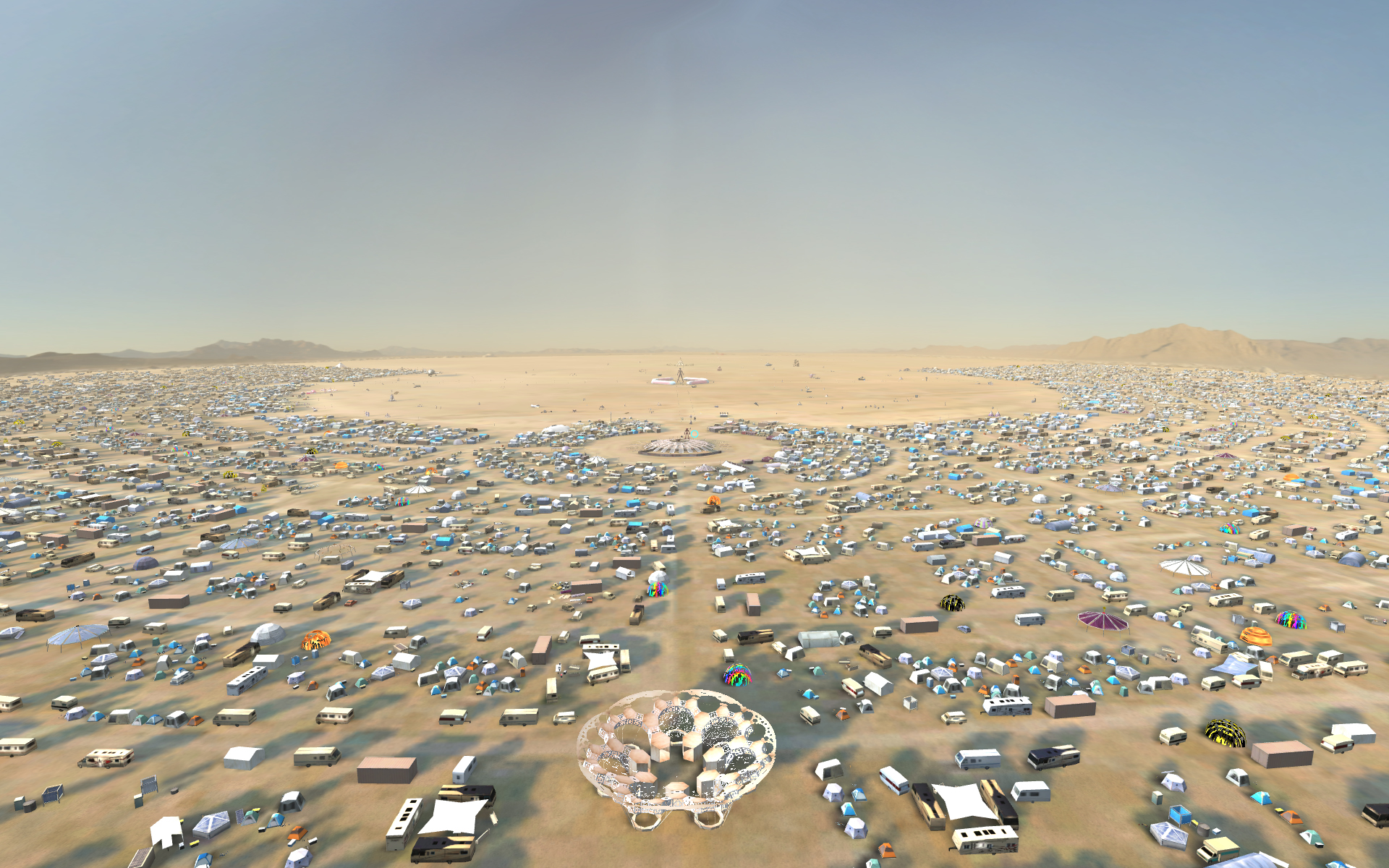

What was it like getting to revisit structures that had previously burned on the playa, specifically the Temple “Galaxia”?
Arthur: It was amazing to be able to relate the body to a structure, or to a place, or to other people while everyone is in a different location. As architects, we create in 3D all the time, we are visualizing in 3D all the time, but we are not physically in that 3D world.
What I find really fascinating is that when we started doing this, we’d meet someone virtually in the structure, and everything was the right scale. That was the first time we really felt the scale of structures we hadn’t been able to see in real life before.
For instance, there was an old Temple that I hadn’t ever seen, and other structures I didn’t have an opportunity to visit on playa at past events. To be able to actually revisit those structures that had burned… It’s like a phoenix, rising from the ashes. You can see all of those past structures.
Relating back to Radical Inclusion, I thought BRCvr was a really nice way to bring people who either couldn’t afford the trip to Black Rock City, or simply couldn’t go because they had other roadblocks. In BRCvr, I got to bring them to “Galaxia.”
Even some of our team members that didn’t make it to see the Temple “Galaxia” on playa in 2018, they felt really emotional walking through “Galaxia” in VR because they were never able to experience it in real life before. Now they’ve seen it. They’ve seen the 3D world it lives in, they’ve seen it to scale.
When you physically enter a space, even in a virtual reality setting, it is very, very different. It becomes real.
“Galaxia” was also the location of your wedding in 2018. What was that like?
Arthur: I’ve got a picture to remind me every day of that moment. It was very special.
We actually got kicked out. Yeah, when we got married in the Temple in 2018, people were like, “Well, it’s OK — just go and sing elsewhere. We have our mourning rituals for this space.”
I mean, it’s nice that people find it sacred, and they want that space. But I thought ‘wouldn’t it be nice to have a counterpoint where people can be loud, and dance, and do those offerings that can be more wild and creative?’ So now we have the juxtaposition of the amphitheater space in “Catharsis,” just for that.
Arthur and his wife Sandy dance at the Temple “Galaxia” after their wedding
Was there anything you extracted from your VR experience that you now use in your day-to-day architectural practice?
Arthur: We started putting all of our projects into VR afterwards. And I started organizing virtual visits with clients. You can really see things with the right scale in VR.
Obviously, we all have great big imaginations, so we can interpret drawings. But this is the real thing. Feedback is more accurate because it’s not feedback that is based on ‘thinking’ the space is huge simply because the drawing makes it look big. It’s like you literally can just walk around and sit down with guests in the space. The VR simulation provides incredible feedback for designers. It has really, really had a big impact on us.
Plus, collaboration is much easier in VR because you’re both physically in the space, so you can give each other live feedback. It helps foster collaboration.
I really enjoy the fact that this experience at BRCvr was so innovative. It was really interesting for me to be a part of.
And you know when they say you just need to go to Burning Man to know what it is? Well, you just need to get goggles to really know what BRCvr is. Because it’s just a whole other world and experience. I strongly recommend 3D goggles.
But BRCvr is just so uncanny. It feels like playa, but it’s not quite. However, because playa is somewhere in our memory, our brain completes the low resolution. It may be low res in VR when you’re in there, but our memory completes Center Camp with all the little details that we remember. So it’s a really interesting space.
Live VR tour of “Catharsis” in BRCvr, interview with Arthur Mamou-Mani by Dezeen:
With the pandemic, an increase in VR experiences, and 3D printing, how do you feel 2020 has changed the future of architecture and art?
Arthur: There is a shift, before and after. A lot of technology that was just emerging at the time is now becoming the norm.
We are 3D printing a lot. We have a giant 3D printer. With “Galaxia,” the central chandelier was all 3D printed. We sent a printer to the generator in Reno, NV, and then we sent the codes from here, so all we had to send was the machine, and then the codes produced the printed pieces for the structure. Obviously, we had amazing people there helping the printing process. But this process — which maybe seemed a bit science-fiction‑ish before — is now becoming much more what the client is actually asking us for.
Now when we are asked to do facades, for example, people can say, “Well, send us some printers and we’ll start printing the facades with local material!” It is much more efficient and it’s also better for the environment, because the machine is light, and the code travels at the speed of light. Plus, there’s obviously no customs, no VAT… so for things like Brexit, it’s so much better.
That’s another dimension of the virtualization of the world, you end up being connected to machines that are sent around the world, and you can use local materials. Then you can also destroy and repurpose those materials. We have a crusher here that we destroy our bioplastics with, and then we print again. You can do that same process with entire buildings, too. You can basically crush them, reprint, maybe change the design, then change it again.
There is something about it that’s really exciting — it’s very, very adaptive. It can change over time, and it can be done with local resources. This is the future, right now.
It’s really been accelerated by the pandemic, because people question traveling. They question their carbon footprint more. All these solutions seem obvious to some extent, but people are more open‑minded now to things like this. I think they’re more aware of their impact on the world.
Cover image of Arthur Mamou-Mani in front of the Temple “Galaxia”, 2018 (Photo by Sandy Kwan)

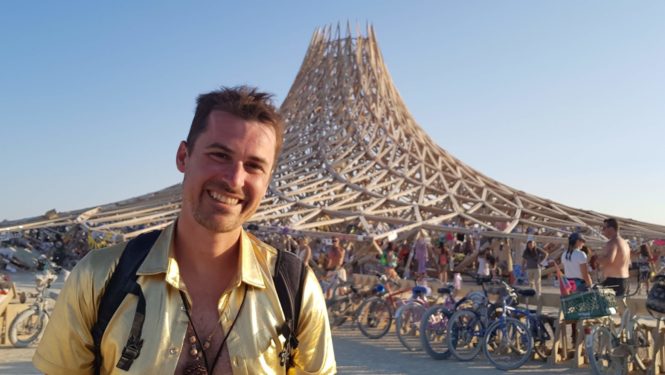
This is such a nice and informing interview really loved it . Thanks a lot and love to meet in real time
Report comment
VR is the way forward for Burning Man. Since it’s not safe to hold the event on the playa, it can be much more inclusive and safer from within our own homes. It can be even better than last year, which was amazing. I’m looking forward to making hundreds and even thousands of virtual friends at Burning Man this year. Safety First!
Report comment
Love it – ritualized disassembly. We need more of that in our lives alongside the powerful experience provided by the burns.
Report comment
burningman.org … Will we, or will we not, be in a position to co-create Black Rock City in 2021? A lot is resting on this decision, and it’s simply too early to make the . and free time we watch the movie
Report comment
This is a great piece, thanks. For what it’s worth, I think playa projects have been happening in virtual worlds (Second Life) since around 2003 (and others since), and with VR capabilities since before 2015 (that was the first time I saw that world in VR). My partner and I have been using virtual worlds to pre-visualize camp builds and art projects since 2011, it’s been very helpful.
Report comment
First off thank you for Galaxia, this creation became a very important space for my wife and I to find a turning point in our healing process that will be eternal. It’s hard to imagine there will be a substitute for the powerful sensory awakening experienced while being physically in the actual Burning Man temple, or watching it be consumed by fire. I never knew of such a feeling and cannot completely describe it but there is an undeniable connection with each individual present when immersed in that environment. It’s was also an absolutely pleasure to watch your candid interview. I have no doubt our paths have and will cross again in the physical. Until then I’ll continue on in gratitude for each moment.
Report comment
This was a bright idea. Really awsome concept. It can be even better than last year, which was amazing. I’m looking forward to making hundreds and even thousands of virtual friends at Burning Man this year. Safety First!
Report comment
Comments are closed.